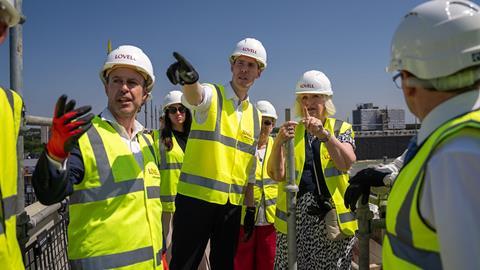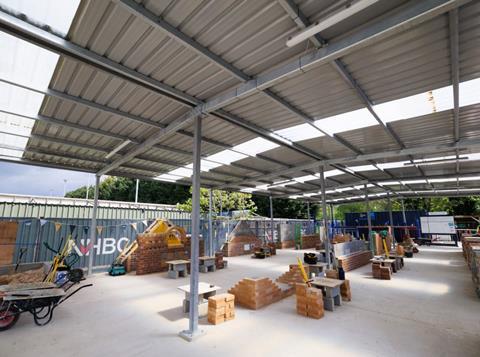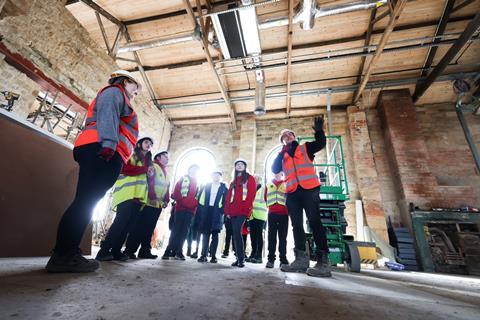Labour shortages pose a huge challenge to the government’s plans for housing and infrastructure. While it is still relatively early days for Keir Starmer and his team, the construction industry is not yet sure whether his party has the answers, writes Daniel Gayne

Amid a flurry of policy launches, scandals and Budget reaction at the end of last year, you could be forgiven for having missed the announcement of the formation of 32 homebuilding skills hubs.
In construction alone, headlines were dominated by the National Planning Policy Framework, where the new government set out the planning policies which will underpin its bold ambition to build 1.5 million homes across the parliament. But, while the skills hubs received relatively little fanfare, the policy is one of a few early clues as to how Labour will approach an issue which will prove pivotal to achieving its more headline-grabbing goals on housing and infrastructure.
Look around and you will see plenty of estimates of how many workers the construction industry needs, when and what for. But, while the experts might haggle over the details, two things are abundantly clear: the number is a big one – and it is much bigger than the number we have got right now.
Workforce demand analysis from the now defunct Infrastructure Projects Authority estimated that, to deliver the £164bn of planned infrastructure investment over the next two years, as many as 360,000 more construction workers will be needed.
According to the Construction Industry Training Board’s (CITB) Construction Skills Network 2024-28 report, 251,500 additional construction workers will be needed over the next four years to meet the anticipated output growth of 2.4% per year.
These high levels of demand are to be placed on an industry with existing shortages, an ageing, shrinking workforce, and a longstanding problem with attracting new talent.
Data from the Employer Skills Survey 2022 showed that, across the economy, the proportion of vacancies in a sector considered to be caused by skills shortage were highest in construction at 52%. Meanwhile, apprenticeship uptake remains stagnant and the CITB reported a net loss of 10,000 workers in 2023 – a 0.9% drop in the overall workforce, which is expected to be followed by a 1.5% drop in 2024 before rates pick up.
The impact of all this is hard to quantify, but again the bottom line is clear: higher labour costs for businesses and delays in the building of the homes and infrastructure which are essential for the country. Last May the House of Commons public accounts committee said that skills shortages were putting at risk plans for major infrastructure delivery.
So, what does Labour plan to do about it? And what do those in the know make of the party’s moves so far?
Almost immediately on taking power, Labour fulfilled its manifesto promise of launching Skills England, a new executive agency which aims to increase flexibility in skills training and cater for specific skills shortages in specific regions. The body, which will replace the Institute for Apprenticeships and Technical Education once the Skills England Bill is passed, already exists as a shadow agency and published its first report last year.
Apprenticeship achievements in Construction, Planning and the Built Environment subjects, England (source: DfE)
| 2018/19 | 2019/20 | 2020/21 | 2021/22 | 2022/23 | 2023/24 | |
|---|---|---|---|---|---|---|
|
Intermediate apprenticeship |
6,616 |
5,548 |
4,989 |
4,406 |
5,156 |
4,848 |
|
Advanced apprenticeship |
3,033 |
2,601 |
2,522 |
2,110 |
2,033 |
1,705 |
|
Higher apprenticeship |
227 |
577 |
870 |
761 |
947 |
1,100 |
|
All apprenticeships |
9,876 |
8,726 |
8,381 |
7,277 |
8,136 |
7,653 |
Under the leadership of former Co-operative boss Richard Pennycook, the body is consulting with employers to provide the Department for Education with views on what priority training should be accessible through the planned growth and skills levy. But, while concept of Skills England has been broadly welcomed across construction, the proof of the pudding will be in the eating.
“As Skills England is still being established, there has been little announcement of the new body’s strategy or programme of work, so there is little to evaluate at this stage,” says Niamh Evans, policy and public affairs officer at the Chartered Institute of Building. She hopes the body will “address fragmentation of the skills system across different levels of national and local government, and help link the government’s work across different departments more closely with the needs of industry”.
Steve Turner, executive director at the Home Builders Federation, similarly says it is “early days” for Skills England and that, while bringing responsibility for skills development into one place could be “a really effective move”, the new body needs to be given enough power and “allowed to set the agenda and lead on policy implementation”.
>> Also read: Skills England proves Labour is serious about its development and growth ambitions
He also speaks warmly of the government’s general approach and engagement with industry on skills, describing it as a “refreshing change of approach from ministers”.
“Early signs are that the government is focused on this as a priority, and the move to devolve money for adult education to combined authorities is a welcome step that has potential to make an impact,” he says.
Shortly after launching Skills England, Keir Starmer and his education secretary, Bridget Phillipson, announced a new growth and skills levy to replace the existing apprenticeship levy. The changes will bring greater flexibility – something which has long been demanded by construction employers – allowing bosses to spend half their levy pot on shorter, modular courses to fill skills gaps identified by industry rather than spending it all on fully fledged apprenticeships.
Then, in mid-December, the government announced further changes to education and training in the built environment, with the Construction T level, first introduced four years ago, scrapped on the basis of low demand.
“In the future, the needs of learners and the economy in this pathway will be met through apprenticeships and other classroom provision,” the government said at the time.

The CIOB’s Evans says that, in light of the defunding of construction T levels and planned reforms to post-16 education, the government needs to “help ensure the national qualification offering ensures there are clear routes for progression into construction careers that are accessible, reputable and appeal to young people”.
Turner at the HBF, meanwhile, stresses the need for further reforms to the levy model. “We require reform of the current model, which sees industry paying two levies – to CITB and the government – such that the process is more flexible and funds can be accessed more easily to deliver training,” he says.
He also says that the CITB itself needs to be “restructured”, noting that some keys skills, such as the installation of heat pumps, currently fall outside its remit.
“Currently less than a third of students on construction courses enter the industry, while we have less than half the number of people holding vocational qualifications compared to our European counterparts. So, quite clearly, urgent change is needed to how we provide construction training in this country,” he adds.
Tessa Hollingworth, managing director of Randstad Construction Property and Engineering, says the government’s levy changes are “a great way to give clients agility to use for upskilling where demand is needed”, but she highlights issues with the curriculum for much of construction training.
We need … more proactive employers going into schools to get the next generation excited about the future of work
Tessa Hollingworth, Randstad
There is “not enough cohesion between the current curriculum and the skills shortages”, she says, citing sustainability skills specifically.
“We need to build a more agile, skill-based curriculum,” she says. “We need to leverage apprenticeships and more proactive employers going into schools to get the next generation excited about the future of work and more focus on us coming together to bridge this issue.”
“I think what Manchester mayor Andy Burnham is doing – going into schools and talking about the skills crisis – is a good example of this.”
Kevin O’Connor, head of social value at Durkan, points out the importance of the government engaging with smaller employers to get a more “rounded view” of the challenges in bringing in new entrants. “It’s important that government understands the realities of risk, cash flow and return on investment for these (often SME) companies when it comes to recruitment and training,” he says.
Professor Andy Westwood, policy director at The Productivity Institute, says sectors like construction and housebuilding need “improved incentives and requirements for building firms and developers to do more training themselves”.
Which brings us onto the latest announcement – 32 homebuilding skills hubs to fast-track training to local areas that need more housing. Announced under the auspices of four different departments (you can see why the creation of Skills England was welcomed by some), the government believes the programme will create 5,000 more construction apprenticeship places per year.
Oversight of the hubs will be split between the Construction Industry Training Board (CITB) and the NHBC. There has been a £140m industry investment in the scheme, £100m of which has come from the NHBC, which will go into its planned network of 12 multi-skills training hubs. These will begin with training in critical areas such as bricklaying, groundwork and site carpentry.
Immersive training meant that we could really accelerate apprenticeship delivery at no loss in quality
Roger Morton, director of business change, NHBC
The NHBC already has four smaller hubs – in Tamworth, Newcastle, Hull and Cambridge – which they say have demonstrated proof of concept.
“Having learnt the lessons there – that immersive training meant that we could really accelerate apprenticeship delivery at no loss in quality – we’ve pushed forward now so that, over the next five years, we aim to open three multi-skills hubs a year,” says Roger Morton, director of business change at the NHBC.
Each of the NHBC’s hubs will deliver 3,000 apprentices a year, trained intensively in real site conditions. “With each site we are working with a developer, but more importantly than that, this really should appeal to small and medium enterprises,” Morton says.
In deciding where to place the new hubs, the NHBC is focused on areas with significant demand for housing (meaning plans to build around 10,000 homes within 30 miles), as well as good transport links and 4,000 sq m to rent for at least 10 years. The rest of the hubs will be launched by the CITB.
The fast-track apprenticeships offered by the hubs, which are scheduled to have launched by 2028, can be completed in 12 to 18 months, up to half the time of a traditional 24 to 30-month construction apprenticeship.
“The great thing about these purpose-built facilities is that they are not limited to classrooms and theoretical discussion, but also offer hands-on instruction mirroring real-world construction sites,” says RICS president Justin Sullivan. Turner also expresses approval of the schemes.

But some will need some convincing. The CIOB’s Evans raises concerns at the fast-track nature of the scheme, stressing the need to ensure that “quality of training is not lost with accelerated apprenticeships”, while Durkan’s O’Connor says that, while “the principle is good”, providing the hubs “is not enough in and of itself”.
“If the hubs are poorly focused or simply replicate existing college offers, then the benefits are likely to be minimal,” he says.
He praises the NHBC’s work on bricklaying at its existing hubs and says his firm has experienced success running refurbishment bootcamps in partnership with the Skills Centre in Stratford.
O’Connor says he sees “huge potential in construction skills boot camps”, emphasising the need to “develop a high quality, flexible and repeatable model that leads directly to employment”.
Dr David Crosthwaite, chief economist at the Building Cost Information Service, says that, while the increase in available construction apprenticeships seems positive, it will “take years to make a material difference on-site”.
What has Labour done so far?
-
Launched Skills England as an executive agency to manage increased training flexibility and tackle specific skills shortages in specific geographical areas
-
Committed to increase the flexibility of the growth and skills levy so government money can be spent on retraining current workers as well as recruiting apprentices
-
Scrapped the construction T level
-
Promised to help the CITB and NHBC set up 32 homebuilding skills hubs to fast-track training in areas with particular housebuilding demand
“In terms of the numbers, 5,000 apprenticeships a year will not be enough to cover those expected to retire or leave the industry annually. So, at best, this is not adding additional workers to an industry that has seen close to 350,000 leave the sector over the last five years,” he says.
He adds that construction needs to make itself a more attractive industry to work in and says more defined career paths would be a start, arguing that greater direct employment and less reliance on sub-contracting would “help in the long run”.
One option available to the government is to welcome higher levels of immigration in order to meet demand. Five construction roles – stonemasons, bricklayers, roofers, carpenters and joiners, retrofitters – are currently on the immigration salary list, after a review conducted in the spring of 2023 by the Migration Advisory Committee.
However, such a move would represent a political defeat for the party, which promised in its manifesto to “end the long-term reliance on overseas workers in some parts of the economy by bringing in workforce and training plans for sectors such as health and social care, and construction”.

However, there is widespread support for a modest increase in non-domestic skilled labour across the industry. Evans at the CIOB says there is “no realistic way to achieve the government’s ambitious programme of construction work in this parliamentary term without an injection of workers from overseas”, while admitting that a heavy dependence on overseas workers may not be “healthy for the sector in the long term”.

>> Read more in-depth research in our Building the Future Think Tank report:
Construction and Immigration - How to make the points based system fit to deliver industry growth
The HBF’s Steve Turner says that, in the short term, some additional overseas support “could be necessary”, but that the industry is “focused on recruiting and developing a home-based workforce and tackling the barriers it currently faces to doing so”.
Crosthwaite, from the BCIS, is more forthright. “In the short run, migrant labour should be encouraged to allow additional workers from overseas to work in the sector,” he says.
“Construction in the UK has historically relied on migrant labour to satisfy peaks in demand and, if Labour’s plans are to be realised, then it seems highly unlikely that they will be met by a shrinking domestic workforce alone.”
Construction migration in numbers
| Bricklayers and masons | Roofers, roof tilers and slaters | Carpenters and joiners | |
|---|---|---|---|
| Number of applications Q1, 2021 – Q1, 2024 | 735 | 194 | 760 |
| Visas granted Q1, 2021 – Q1, 2024 | 606 | 130 | 641 |
Source: Home Office
Beyond the hubs, levies and quangos, there is widespread agreement that the government and industry has historically been too narrow in targeting new workers. To fix this, the sector needs to look younger, older, and outside the box.
RICS president Justin Sullivan believes it will be necessary to “inspire more people to consider the built environment from school age”. He suggests establishing a built environment GCSE in England.
The vast majority of initiatives – including at present the boot camps – either preclude people in employment or make it impossible to take part because workers can’t survive without wages
Kevin O’Connor, head of social value, Durkan
Such a qualification already exists in Wales and the House of Lords built environment committee has previously endorsed following suit.
Meanwhile, O’Connor at Durkan says the focus “purely on young people and the unemployed is a huge problem”, noting the “excellent” opportunities in construction for workers over the age of 24.
“The industry would love to get its hands on those thousands of workers in ‘precarious employment’ who already have the core qualities required by construction employers,” he says. “However, the vast majority of initiatives – including at present the boot camps – either preclude people in employment or make it impossible to take part because workers can’t survive without wages.”
O’Connor says that, in his experience, these self-funders are “some of the most motivated, hard-working, and dependable candidates you will ever meet”. He suggests the government considers a four to five-week investment to fund the wages of this group so they can take part in boot camps.

Patricia Moore, UK managing director at Turner & Townsend, says that policy also needs to move on from a focus on “traditional occupations”.
“Bricklaying and on-site carpentry are essential skills, but we also need to recognise the challenge we face is not simply about attracting more people, but broader capabilities too,” she says, adding that Skills England would need to better reflect “the changing face of construction within its skills initiatives”.
“A modern construction sector is the engine through which we will deliver national ambitions to drive growth, address inequality and decarbonise the economy,” she says. “We need the skills to match – including attracting talent in digital and sustainability in particular.”
Labour has made significant manifesto commitments without creating a clear plan of how it will realistically be able to meet these pledges in their promised timeframe
Niamh Evans, policy and public affairs officer, CIOB
Two phrases came up repeatedly among those to whom Building spoke to for this article: “step in the right direction” and “too soon to tell”.
While it has been an eventful half-year since Labour was elected, this remains a young government. The built environment sector has broadly welcomed the moves it has made on the skills front so far, but it is nonetheless reserving judgment – and there is some concern that we have been here before.
As Evans puts it: “As seems to be a trend of successive governments, Labour has made significant manifesto commitments without creating a clear plan of how it will realistically be able to meet these pledges in their promised timeframe.”
A week is a long time in politics, the saying goes, but, in construction, five years does not seem quite so long. The government has made its bed with its promises to “build, build, build” in this parliament, but the skills crisis it has inherited means it has its work cut out in order to fulfil them.
The Department for Education, Ministry for Housing, Communities and Local Government, Department for Work and Pensions, Department for Business and Trade, and Construction Industry Training Board were all contacted for comment.
Secure your spot at Building’s Good Employer Guide Live!

6 March 2025 | The Royal Institution, 21 Albemarle Street, London, W1S 4BS
This CPD-accredited event features two debates on skills and EDI issues, a keynote speech, networking drinks, the launch of Building’s 2025 Good Employer Guide, and a Workforce of the Future report for Housing Today.
Join us to hear from companies with some of the most forward-thinking careers initiatives and find out more about what it takes to be a good employer in the built environment today.


























No comments yet